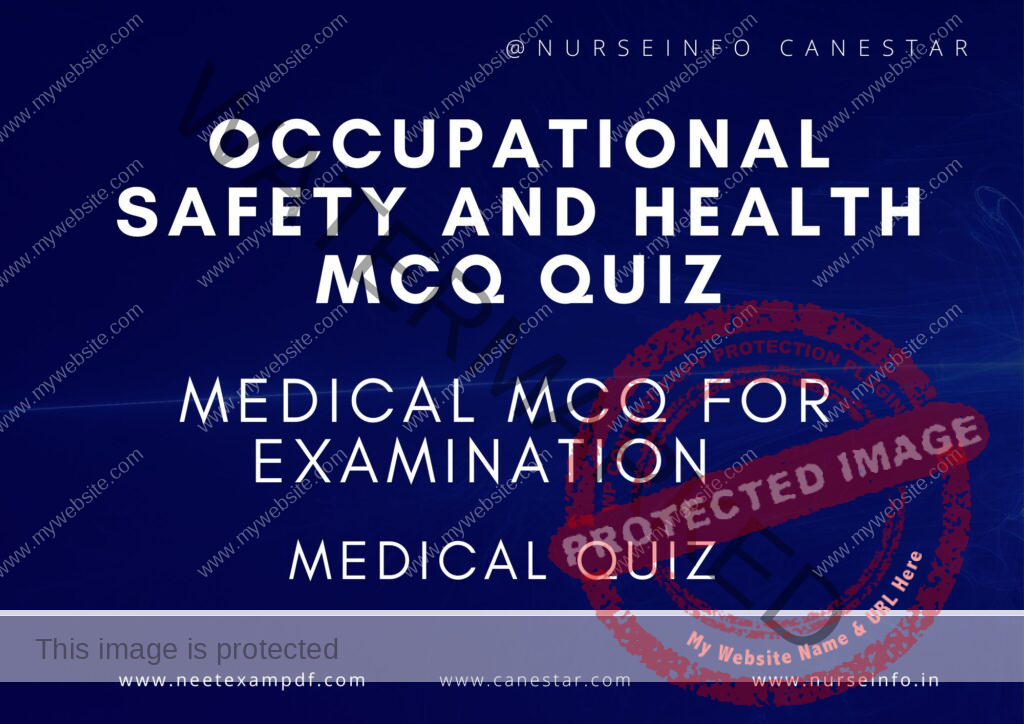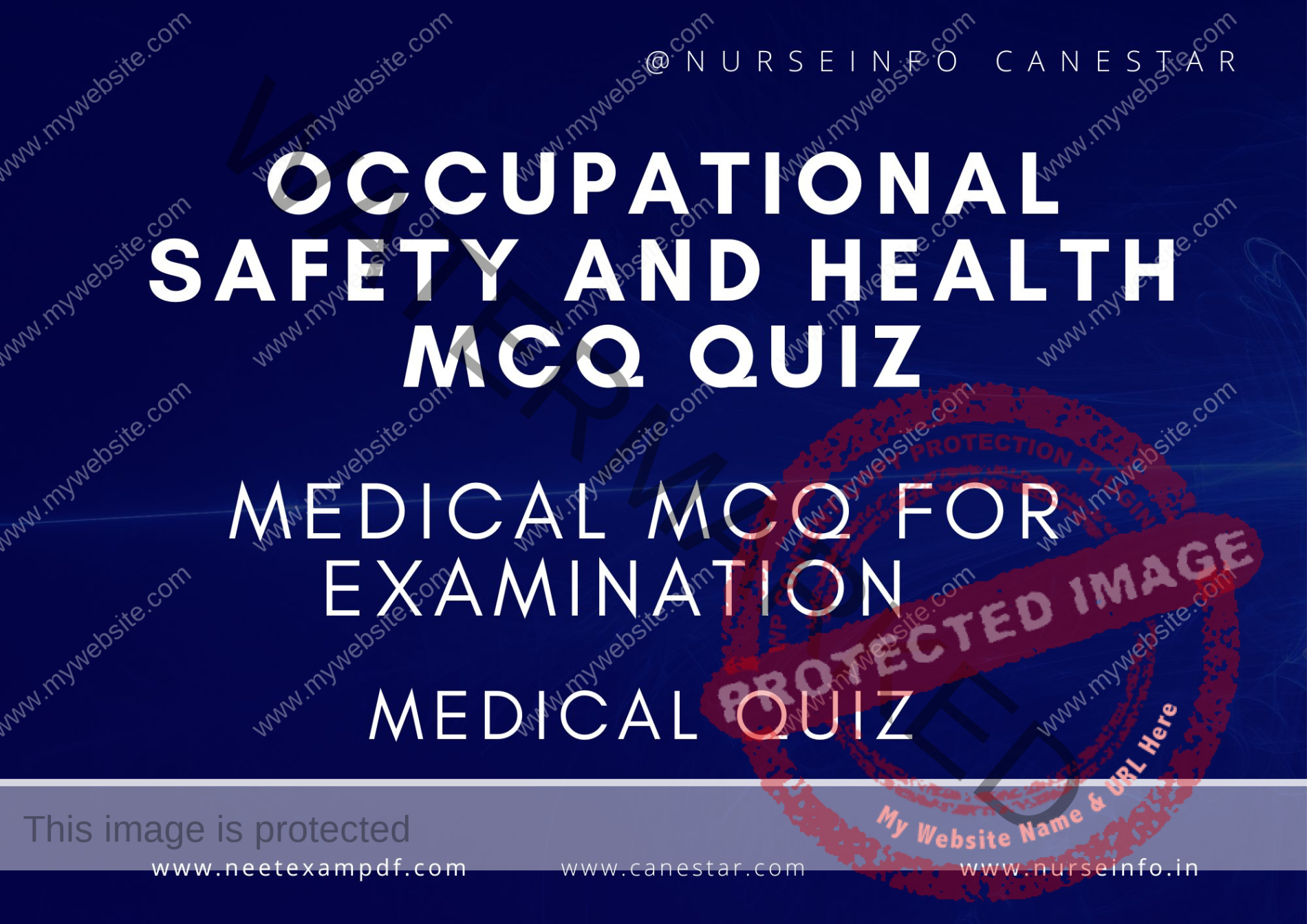MULTIPLE CHOICE QUESTIONS ON OCCUPATIONAL SAFETY AND HEALTH PRACTICE QUIZ – MCQS WITH RATIONALE ANSWER – OCCUPATIONAL SAFETY AND HEALTH MCQ QUESTIONS WITH RATIONALE
MCQ FOR OCCUPATIONAL SAFETY AND HEALTH QUIZ
These mcqs are prepared exclusively for medical professionals for exam preparation. MCQ is helpful to remember the concept on occupational safety and health mcq quiz. This multiple choice questions are helpful for preparation for DHA, PROMETRIC, MOH, HAAD, NCLEX, Medical, NEET and Nursing EXAMINATION
OCCUPATIONAL SAFETY AND HEALTH MCQ QUIZ
1. Which of the following is a primary goal of occupational safety and health programs?
A. Reducing healthcare costs
B. Increasing production rates
C. Preventing workplace injuries and illnesses
D. Enhancing employee satisfaction
Answer: C. Preventing workplace injuries and illnesses
Rationale: The primary goal of occupational safety and health programs is to prevent workplace injuries and illnesses to ensure a safe working environment.
2. Which organization is responsible for enforcing workplace safety and health regulations in the United States?
A. WHO
B. OSHA
C. CDC
D. NIH
Answer: B. OSHA
Rationale: The Occupational Safety and Health Administration (OSHA) is responsible for enforcing workplace safety and health regulations in the United States.
3. Personal protective equipment (PPE) is used to:
A. Increase productivity
B. Reduce exposure to hazards
C. Enhance communication
D. Improve comfort
Answer: B. Reduce exposure to hazards
Rationale: Personal protective equipment (PPE) is used to reduce exposure to hazards that could cause injuries or illnesses in the workplace.
4. The term “ergonomics” refers to:
A. Designing equipment for comfort and efficiency
B. Studying disease transmission
C. Assessing chemical hazards
D. Evaluating environmental impact
Answer: A. Designing equipment for comfort and efficiency
Rationale: Ergonomics is the science of designing equipment and work tasks to fit the worker, enhancing comfort, efficiency, and safety.
5. Which of the following is a common ergonomic hazard in the workplace?
A. Chemical exposure
B. Poor posture
C. Loud noise
D. Electrical wiring
Answer: B. Poor posture
Rationale: Poor posture is a common ergonomic hazard that can lead to musculoskeletal disorders and other health issues.
6. Which document outlines the procedures for handling hazardous substances in the workplace?
A. Emergency action plan
B. Material Safety Data Sheet (MSDS)
C. Incident report form
D. Employee handbook
Answer: B. Material Safety Data Sheet (MSDS)
Rationale: The Material Safety Data Sheet (MSDS) provides information on the properties, handling, storage, and emergency procedures related to hazardous substances.
7. What is the primary purpose of conducting a job hazard analysis (JHA)?
A. To increase production speed
B. To identify and control workplace hazards
C. To evaluate employee performance
D. To improve workplace aesthetics
Answer: B. To identify and control workplace hazards
Rationale: The primary purpose of conducting a job hazard analysis (JHA) is to identify and control hazards associated with specific job tasks.
8. Which of the following is an example of an administrative control in occupational safety?
A. PPE usage
B. Machine guarding
C. Safety training programs
D. Ventilation systems
Answer: C. Safety training programs
Rationale: Administrative controls include policies and procedures such as safety training programs to reduce risk by promoting safe practices.
9. Noise levels exceeding what decibel level require hearing protection in the workplace?
A. 50 dB
B. 70 dB
C. 85 dB
D. 100 dB
Answer: C. 85 dB
Rationale: OSHA requires hearing protection when noise levels exceed 85 decibels over an 8-hour time-weighted average.
10. What is the purpose of a lockout/tagout (LOTO) procedure?
A. To secure premises
B. To prevent unauthorized access
C. To ensure safe maintenance of equipment
D. To enhance fire safety
Answer: C. To ensure safe maintenance of equipment
Rationale: Lockout/tagout (LOTO) procedures are designed to ensure the safe maintenance and servicing of machinery by preventing accidental energy release.
11. Which of the following is a biological hazard in the workplace?
A. Asbestos
B. Loud noise
C. Mold spores
D. Ergonomic strain
Answer: C. Mold spores
Rationale: Biological hazards include organisms like mold spores that can cause health issues such as respiratory problems and allergic reactions.
12. A fire extinguisher labeled “Class A” is suitable for which type of fire?
A. Electrical fires
B. Flammable liquids
C. Combustible metals
D. Ordinary combustibles
Answer: D. Ordinary combustibles
Rationale: Class A fire extinguishers are designed for fires involving ordinary combustibles like wood, paper, and cloth.
13. What is the purpose of a workplace safety inspection?
A. To increase production rates
B. To identify and correct safety hazards
C. To evaluate employee performance
D. To ensure employee comfort
Answer: B. To identify and correct safety hazards
Rationale: Workplace safety inspections aim to identify and correct safety hazards to prevent workplace injuries and illnesses.
14. Which of the following is considered a physical hazard?
A. Chemical spill
B. Loud noise
C. Bacterial infection
D. Repetitive motion
Answer: B. Loud noise
Rationale: Physical hazards include environmental factors such as loud noise that can cause harm to workers.
15. Which type of training is essential for workers handling hazardous materials?
A. Ergonomics training
B. First aid training
C. Hazard communication training
D. Fire safety training
Answer: C. Hazard communication training
Rationale: Hazard communication training is essential for workers handling hazardous materials to understand the risks and proper handling procedures.
16. What is the primary focus of the National Institute for Occupational Safety and Health (NIOSH)?
A. Regulating workplace safety
B. Conducting research and making recommendations
C. Providing healthcare services
D. Inspecting workplaces
Answer: B. Conducting research and making recommendations
Rationale: NIOSH conducts research and makes recommendations for the prevention of work-related injuries and illnesses.
17. Which of the following measures can help prevent slips, trips, and falls in the workplace?
A. Wearing gloves
B. Proper lighting
C. Using earplugs
D. Providing safety glasses
Answer: B. Proper lighting
Rationale: Proper lighting can help prevent slips, trips, and falls by ensuring that workers can see potential hazards clearly.
18. In a chemical spill, which type of control should be implemented first?
A. Administrative control
B. Engineering control
C. PPE
D. Elimination
Answer: D. Elimination
Rationale: The first step in controlling a chemical spill is to eliminate the source of the spill if it can be done safely, followed by other control measures.
19. Which of the following is an example of an engineering control to reduce exposure to airborne contaminants?
A. Respirators
B. Safety goggles
C. Ventilation systems
D. Safety signage
Answer: C. Ventilation systems
Rationale: Engineering controls, such as ventilation systems, help to reduce exposure to airborne contaminants by removing them from the air.
20. The “Hierarchy of Controls” in occupational safety prioritizes which of the following measures first?
A. PPE
B. Administrative controls
C. Engineering controls
D. Elimination or substitution
Answer: D. Elimination or substitution
Rationale: The Hierarchy of Controls prioritizes elimination or substitution of hazards as the most effective measures for controlling risks in the workplace.


